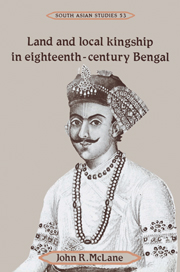Book contents
- Frontmatter
- Contents
- List of tables
- Preface and acknowledgments
- List of abbreviations
- Select glossary
- Map of southwest Bengal
- Part I Bengal
- Part II Burdwan
- 6 Mughal Burdwan and the rise of the Burdwan raj
- 7 Burdwan's expansion
- 8 The Maratha invasions, 1742-1751
- 9 Zamindars and the transition to Company rule
- 10 The famine of 1770
- 11 Revenue farming, 1771-1777
- 12 Zamindari family politics: the Burdwan raj, 1770-1775
- 13 The politics of Burdwan family debt and marriages, 1775-1778
- 14 Testing the limits, 1778–1790
- 15 Burdwan under the Decennial and Permanent Settlements
- 16 Patnis and the elusive quest for independence and security
- 17 Conclusion
- Bibliography
- Index
- Cambridge South Asian Studies
15 - Burdwan under the Decennial and Permanent Settlements
from Part II - Burdwan
Published online by Cambridge University Press: 13 October 2009
- Frontmatter
- Contents
- List of tables
- Preface and acknowledgments
- List of abbreviations
- Select glossary
- Map of southwest Bengal
- Part I Bengal
- Part II Burdwan
- 6 Mughal Burdwan and the rise of the Burdwan raj
- 7 Burdwan's expansion
- 8 The Maratha invasions, 1742-1751
- 9 Zamindars and the transition to Company rule
- 10 The famine of 1770
- 11 Revenue farming, 1771-1777
- 12 Zamindari family politics: the Burdwan raj, 1770-1775
- 13 The politics of Burdwan family debt and marriages, 1775-1778
- 14 Testing the limits, 1778–1790
- 15 Burdwan under the Decennial and Permanent Settlements
- 16 Patnis and the elusive quest for independence and security
- 17 Conclusion
- Bibliography
- Index
- Cambridge South Asian Studies
Summary
Zamindars entered a new era in the spring of 1790 when the Company offered them ten-year settlements. Those settlements were declared permanent in 1793. The distinctive feature of the Decennial and Permanent Settlements was not that they were made with the zamindars. Zamindars, of course, had been collectors for most of the eighteenth century. Nor was the level of the demand remarkable since it was but “marginally” higher than previously, although “stable or falling” agricultural prices in the 1790s made the demand difficult to realize. Instead, the crucial innovations were the permanency and the mode of recovering arrears. In the long run, the fixity of the land tax attracted investments into the developmental dead-end of rent-collecting rights, rather than into forms of enterprise that were likely to lead to higher productivity or balanced economic growth. In the long run, the fixed tax declined as a proportion of the money supply as inflation and the cultivation of new lands vastly expanded the rental income available from the working peasants.
The other crucial innovation of the 1790 and 1793 settlements was that zamindars' hereditary rights to collect the revenue were required to serve as security for the government's revenue, in practice as well as in theory. Beginning in 1790, failure to meet the government demand normally led to sale at public auction of that portion of a zamindari estate sufficient to realize the arrears. Other expedients for recovering arrears, such as temporary remissions, khas management, management by a sazawal, and short-term leases to farmers, no longer were used except in unusual circumstances.
- Type
- Chapter
- Information
- Land and Local Kingship in Eighteenth-Century Bengal , pp. 267 - 286Publisher: Cambridge University PressPrint publication year: 1993



